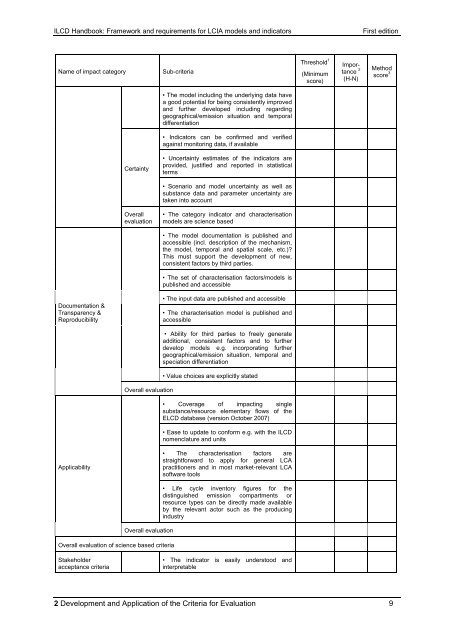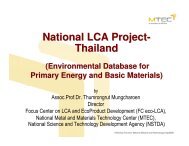ILCD Handbook: Framework and requirements for LCIA models and ...
ILCD Handbook: Framework and requirements for LCIA models and ...
ILCD Handbook: Framework and requirements for LCIA models and ...
Create successful ePaper yourself
Turn your PDF publications into a flip-book with our unique Google optimized e-Paper software.
<strong>ILCD</strong> <strong>H<strong>and</strong>book</strong>: <strong>Framework</strong> <strong>and</strong> <strong>requirements</strong> <strong>for</strong> <strong>LCIA</strong> <strong>models</strong> <strong>and</strong> indicators First edition<br />
Name of impact category Sub-criteria<br />
Documentation &<br />
Transparency &<br />
Reproducibility<br />
Applicability<br />
Certainty<br />
Overall<br />
evaluation<br />
Overall evaluation<br />
Overall evaluation<br />
Overall evaluation of science based criteria<br />
Stakeholder<br />
acceptance criteria<br />
• The model including the underlying data have<br />
a good potential <strong>for</strong> being consistently improved<br />
<strong>and</strong> further developed including regarding<br />
geographical/emission situation <strong>and</strong> temporal<br />
differentiation<br />
• Indicators can be confirmed <strong>and</strong> verified<br />
against monitoring data, if available<br />
• Uncertainty estimates of the indicators are<br />
provided, justified <strong>and</strong> reported in statistical<br />
terms<br />
• Scenario <strong>and</strong> model uncertainty as well as<br />
substance data <strong>and</strong> parameter uncertainty are<br />
taken into account<br />
• The category indicator <strong>and</strong> characterisation<br />
<strong>models</strong> are science based<br />
• The model documentation is published <strong>and</strong><br />
accessible (incl. description of the mechanism,<br />
the model, temporal <strong>and</strong> spatial scale, etc.)?<br />
This must support the development of new,<br />
consistent factors by third parties.<br />
• The set of characterisation factors/<strong>models</strong> is<br />
published <strong>and</strong> accessible<br />
• The input data are published <strong>and</strong> accessible<br />
• The characterisation model is published <strong>and</strong><br />
accessible<br />
• Ability <strong>for</strong> third parties to freely generate<br />
additional, consistent factors <strong>and</strong> to further<br />
develop <strong>models</strong> e.g. incorporating further<br />
geographical/emission situation, temporal <strong>and</strong><br />
speciation differentiation<br />
• Value choices are explicitly stated<br />
• Coverage of impacting single<br />
substance/resource elementary flows of the<br />
ELCD database (version October 2007)<br />
• Ease to update to con<strong>for</strong>m e.g. with the <strong>ILCD</strong><br />
nomenclature <strong>and</strong> units<br />
• The characterisation factors are<br />
straight<strong>for</strong>ward to apply <strong>for</strong> general LCA<br />
practitioners <strong>and</strong> in most market-relevant LCA<br />
software tools<br />
• Life cycle inventory figures <strong>for</strong> the<br />
distinguished emission compartments or<br />
resource types can be directly made available<br />
by the relevant actor such as the producing<br />
industry<br />
• The indicator is easily understood <strong>and</strong><br />
interpretable<br />
Threshold 1<br />
(Minimum<br />
score)<br />
Importance<br />
2<br />
(H-N)<br />
Method<br />
score 3<br />
2 Development <strong>and</strong> Application of the Criteria <strong>for</strong> Evaluation 9



